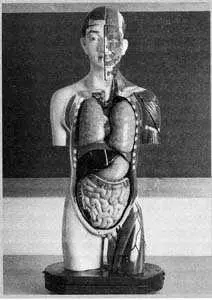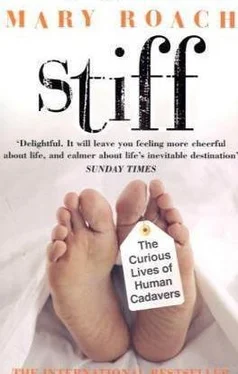he is quoted as saying. “Pray let it keep in!” Cooper persisted, cursing the man’s deep perineum (in fact, an autopsy showed it to be a quite normally proportioned perineum). After digging with his finger for some ungodly amount of time, he got up from his seat and “measured fingers with those of other gentlemen, to see if any of them had a longer finger.”
Eventually he went back to his toolkit and, with forceps, conquered the recalcitrant rock—a relatively small one, “not larger than a common Windsor bean”—brandishing it above his head like an Academy Award winner. The quivering, exhausted mass that was Stephen Pollard was wheeled to a bed, where he died of infection and God knows what else twenty-nine hours later.
Bad enough that some ham-handed fop in a waistcoat and bowtie was up to his wrists in your urinary tract, but on top of that you had an audience—not just the young punters from the medical school but, judging from a description of another lithotomy at Guy’s Hospital in an 1829 Lancet , half the city: “Surgeons and surgeons’ friends… French visitors, and interlopers filled the space around the table… There was soon a general outcry throughout the gallery and upper rows—‘hat’s off,’ ‘down heads,’ …was loudly vociferated from different parts of the theatre.”
The cabaret atmosphere of early medical instruction began centuries before, in the standing-room-only dissecting halls of the renowned Italian medical academies of Padua and Bologna. According to C. D. O’Malley’s biography of the great Renaissance anatomist Andreas Vesalius, one enthusiastic spectator at a crowded Vesalius dissection, bent on a better view, leaned too far out and tumbled from his bench to the dissecting platform below. “Because of his accidental fall… the unfortunate Master Carlo is unable to attend and is not very well,” read the note proffered at the next lecture. Master Carlo, one can be sure, did not seek treatment at the place he went for lectures.
Without exception, the only people who checked themselves in at teaching hospitals were those too poor to pay for private surgery. In return for an operation that was as likely to kill them as make them better—bladder stone removal had a mortality rate of 50 percent—the poor basically donated themselves as living practice material. Not only were the surgeons unskilled, but many of the operations being done were purely experimental—no one really expected them to help. Wrote historian Ruth Richardson in Death, Dissection, and the Destitute , “The benefit [to the patient] was often incidental to the experiment.”
With the advent of anesthesia, patients were at least unconscious while the young resident tried his hand at a new procedure. But they probably didn’t give their permission for a trainee to take the helm. In the heady days before consent forms and drop-of-a-hat lawsuits, patients didn’t realize what they might be in for if they underwent surgery at a teaching hospital, and doctors took advantage of this fact. While a patient was under, a surgeon might invite a student to practice an appendectomy.
Never mind that the patient didn’t have appendicitis. One of the more common transgressions was the gratuitous pelvic exam. A budding M.D.’s first Pap smear—the subject of significant anxiety and dread-—was often administered to an unconscious female surgical patient. (Nowadays, enlightened medical schools will hire a “pelvic educator,” a sort of professional vagina who allows the students to practice on her and offers personalized feedback and is, in my book anyway, a nominee for sainthood.)
Gratuitous medical procedures happen far less than they used to, owing to the public’s growing awareness. “Patients are savvier these days, and the climate has changed a great deal,” Hugh Patterson, who runs the willed body program at the University of California, San Francisco, Medical School, told me. “Even at a teaching hospital, patients request that residents not do the surgery. They want to be assured the attending does the procedure. It makes training very difficult.”
Patterson would like to see specialized cadaver anatomy labs added to third- and fourth-year programs—instead of teaching anatomy only in the first year, “as one big bolus.” Already, he and his colleagues have added a focused dissection, similar to the facial anatomy lab I’m observing today, to the curricula of surgical subspecialties. They’ve also set up a series of sessions at the medical school morgue to teach emergency room procedures to third-year students. Before a cadaver is embalmed and delivered to the anatomy lab, it may pass an afternoon getting tracheal intubations and catheterizations. (Some schools use anesthetized dogs for this purpose.) Given the urgency and difficulty of certain ER procedures, it makes good sense to practice them first on the dead. In the past, this has been done in a less formal manner, on freshly dead hospital patients, without consent—a practice whose propriety is intermittently debated in hushed meetings of the American Medical Association. They should probably just ask for permission: According to one New England Journal of Medicine study on the subject, 73 percent of parents of newly dead children, when asked, gave consent to use their child’s body for teaching intubation skills.
I ask Marilena if she plans to donate her remains. I have always assumed that a sense of reciprocity prompts doctors to donate— repayment for the generosity of the people they dissected in medical school. Marilena, for one, isn’t going to. She cites a lack of respect. It surprises me to hear her say this. As far as I can tell, the heads are being treated with respect. I hear no joking or laughter or callous comments. If there can be a respectful way to “deglove” a face, if loosening the skin of someone’s forehead and flipping it back over his or her eyes can be a respectful act, then I think these people are managing it. It’s strictly business.
It turns out that what Marilena objected to was a couple of the surgeons’ taking photographs of their cadaver heads. When you take a photograph of a patient for a medical journal, she points out, you have the patient sign a release. The dead can’t refuse to sign releases, but that doesn’t mean they wouldn’t want to. This is why cadavers in photographs in pathology and forensics journals have black bars over their eyes, like women on the Dos and Don’ts pages of Glamour . You have to assume that people don’t want to be photographed dead and dismembered, any more than they want to be photographed naked in the shower or asleep on a plane with their mouth hanging open.
Most doctors aren’t worried about a lack of respect from other doctors.
Most of the ones I’ve spoken to would worry, if anything, about a lack of respect from students in the first-year gross anatomy lab—my next stop.
The seminar is nearly over. The video monitors are blank and the surgeons are cleaning up and filing out into the hallway. Marilena replaces the white cloth on her cadaver’s face; about half the surgeons do this. She is conscientiously respectful. When I asked her why the eyes of the dead woman had no pupils, she did not answer, but reached up and closed the eyelids. As she slides back her chair, she looks down at the benapkined form and says, “May she rest in peace.” I hear it as “pieces,” but that’s just me.
2. CRIMES OF ANATOMY
Body Snatching and Other Sordid Tales from the Dawn of Human Dissection

Enough years have passed since the use of Pachelbel’s Canon in a fabric softener commercial that the music again sounds pure and sweetly sad to me. It’s a good choice for a memorial service, a classic and effective choice, for the men and women gathered (here today) have fallen silent and somber with the music’s start.
Читать дальше













